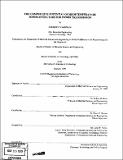| dc.contributor.advisor | Robert M. Rose and Bruce P. Strauss. | en_US |
| dc.contributor.author | Campbell, Andrew Z. (Andrew Zachary), 1970- | en_US |
| dc.date.accessioned | 2005-08-19T19:49:38Z | |
| dc.date.available | 2005-08-19T19:49:38Z | |
| dc.date.copyright | 1999 | en_US |
| dc.date.issued | 1999 | en_US |
| dc.identifier.uri | http://hdl.handle.net/1721.1/9737 | |
| dc.description | Thesis (S.M.)--Massachusetts Institute of Technology, Dept. of Materials Science and Engineering; and, (S.M.)--Massachusetts Institute of Technology, Sloan School of Management, Technology and Policy Program, 1999. | en_US |
| dc.description | Includes bibliographical references (leaves 78-82). | en_US |
| dc.description.abstract | High temperature superconductors were discovered in 1987. World-wide, many groups are presently engaged in the research and development of these materials for power transmission cable applications. This thesis examines the competitive potential, on a cost-performance basis, of high-temperature superconductors as compared to conventional transmission lines. Toward this end, a broad survey of the literature on high-temperature superconducting (HTS) cables and tapes was performed. An analysis of the critical interdependencies between HTS technology and their cost-competitiveness for power transmission are presented. This thesis makes clear that there are technical characteristics unique to HTS which place them at a significant economic handicap for alternating-current power transmission as compared to direct-current power transmission. HTS tape is the integral component of a HTS cable. In turn, silver metal is an integral component of HTS tapes and there is little technological scope for reducing the amount of silver required for HTS tape. While the cost of silver was found to be a minority fraction of the total cost of HTS tape, this cost alone, on a cost performance basis, would approach the entire final installation cost of a standard overhead direct-current transmission line for a I km length. However, because the properties of HTS tape continuously deteriorate with distance, their competitiveness would also progressively deteriorate for longer transmission distance. The reduction of transmission losses is not a compelling source of competitive advantage for HTS cable. A HTS direct-current cable would not eliminate all transmission losses and there is considerable technical debate over whether such a cable would have any loss-savings advantage over a standard direct-current transmission line. However, were a completely lossfree transmission line possible, it would merit a premium, under the most optimistic scenario, of approximately 76% over the final installation cost of a standard direct-current overhead transmission line, and about 7.6% more than the cost of an equivalent underground directcurrent cable. | en_US |
| dc.description.statementofresponsibility | by Andrew Z. Campbell. | en_US |
| dc.format.extent | 82 leaves | en_US |
| dc.format.extent | 6244740 bytes | |
| dc.format.extent | 6244496 bytes | |
| dc.format.mimetype | application/pdf | |
| dc.format.mimetype | application/pdf | |
| dc.language.iso | eng | en_US |
| dc.publisher | Massachusetts Institute of Technology | en_US |
| dc.rights | M.I.T. theses are protected by copyright. They may be viewed from this source for any purpose, but reproduction or distribution in any format is prohibited without written permission. See provided URL for inquiries about permission. | en_US |
| dc.rights.uri | http://dspace.mit.edu/handle/1721.1/7582 | |
| dc.subject | Materials Science and Engineering | en_US |
| dc.subject | Sloan School of Management | en_US |
| dc.subject | Technology and Policy Program | en_US |
| dc.title | The competitive potential of high-temperature superconductors for power transmission | en_US |
| dc.type | Thesis | en_US |
| dc.description.degree | S.M. | en_US |
| dc.contributor.department | Massachusetts Institute of Technology. Department of Materials Science and Engineering | en_US |
| dc.contributor.department | Technology and Policy Program | en_US |
| dc.contributor.department | Sloan School of Management | en_US |
| dc.identifier.oclc | 42720865 | en_US |
